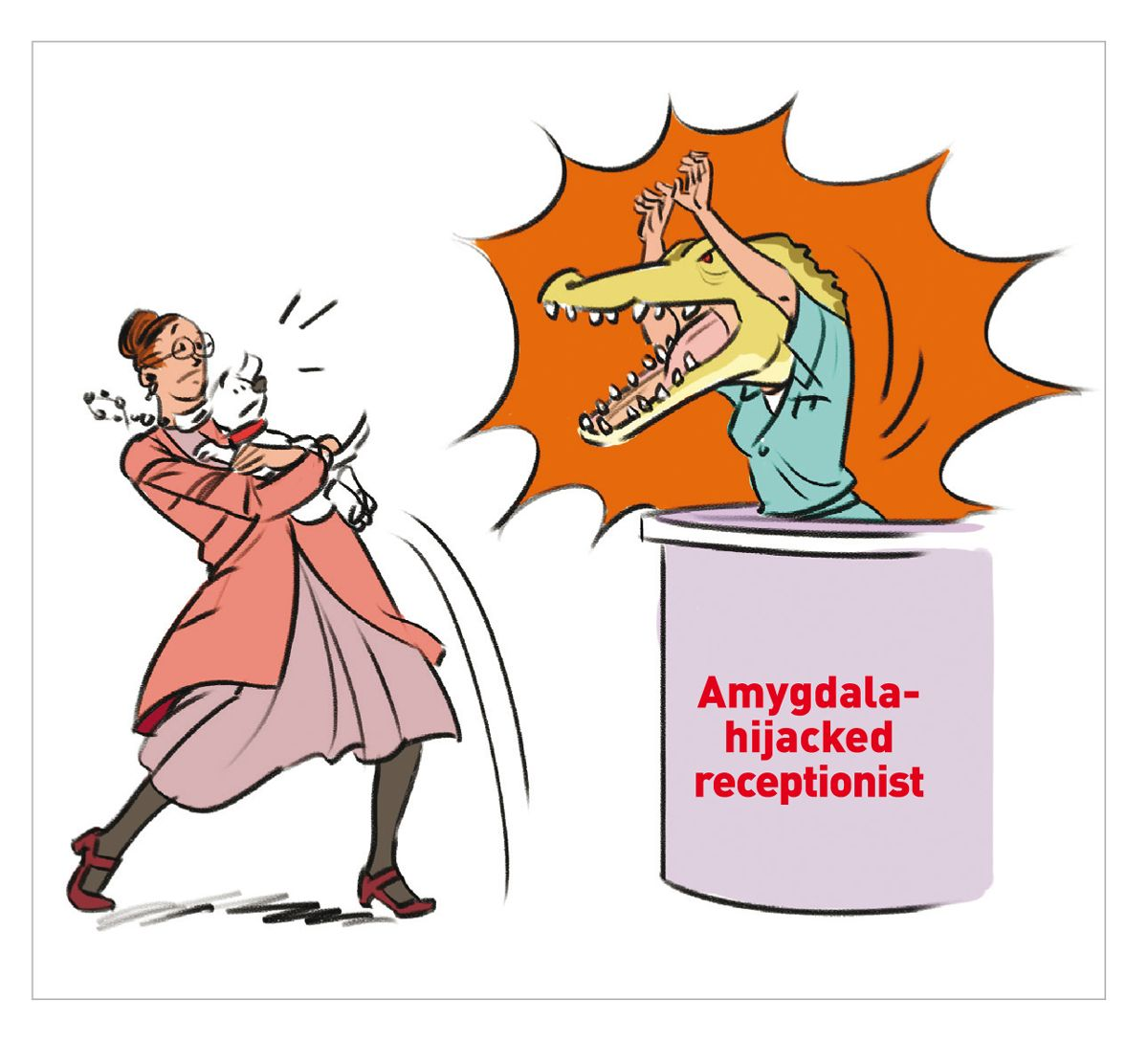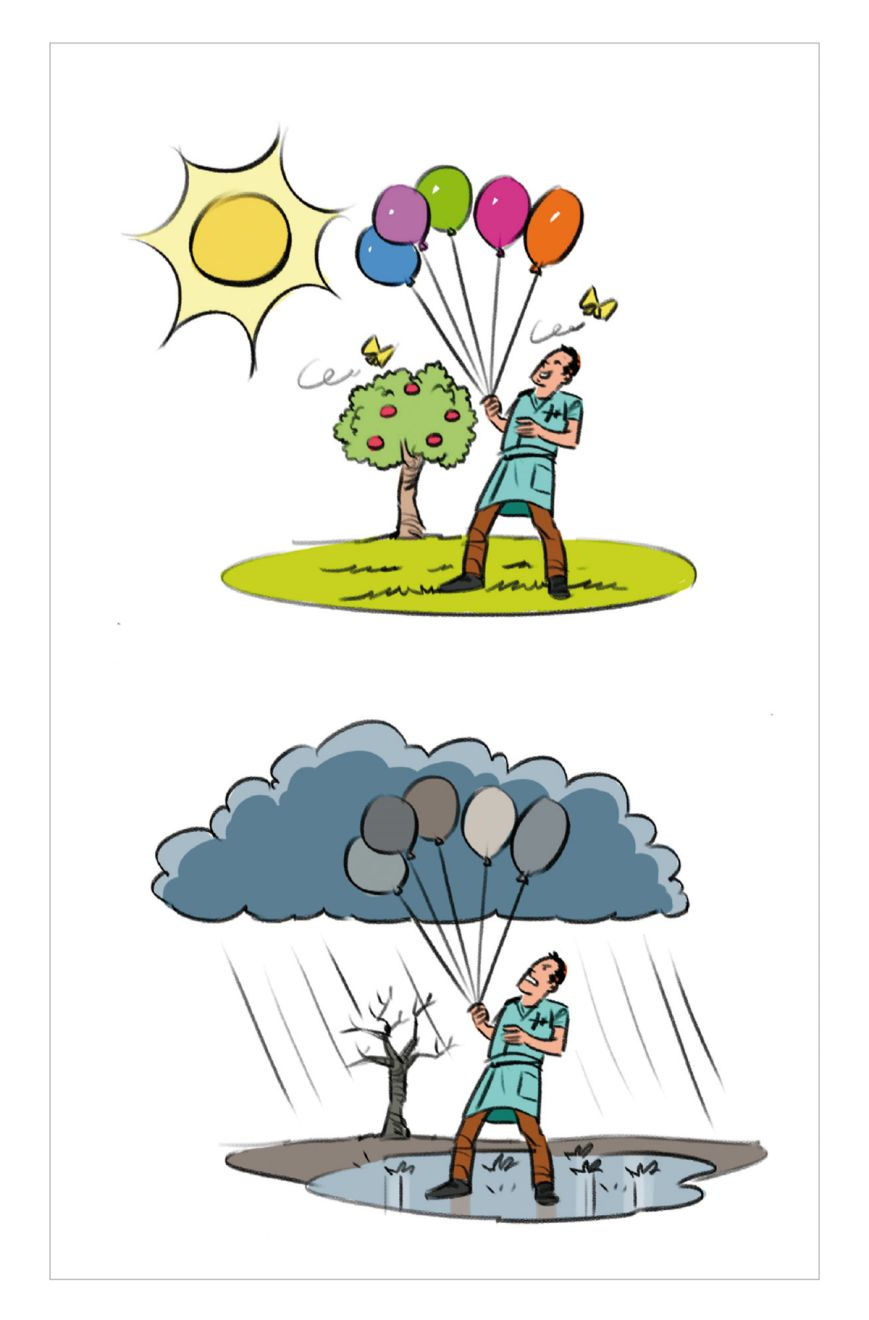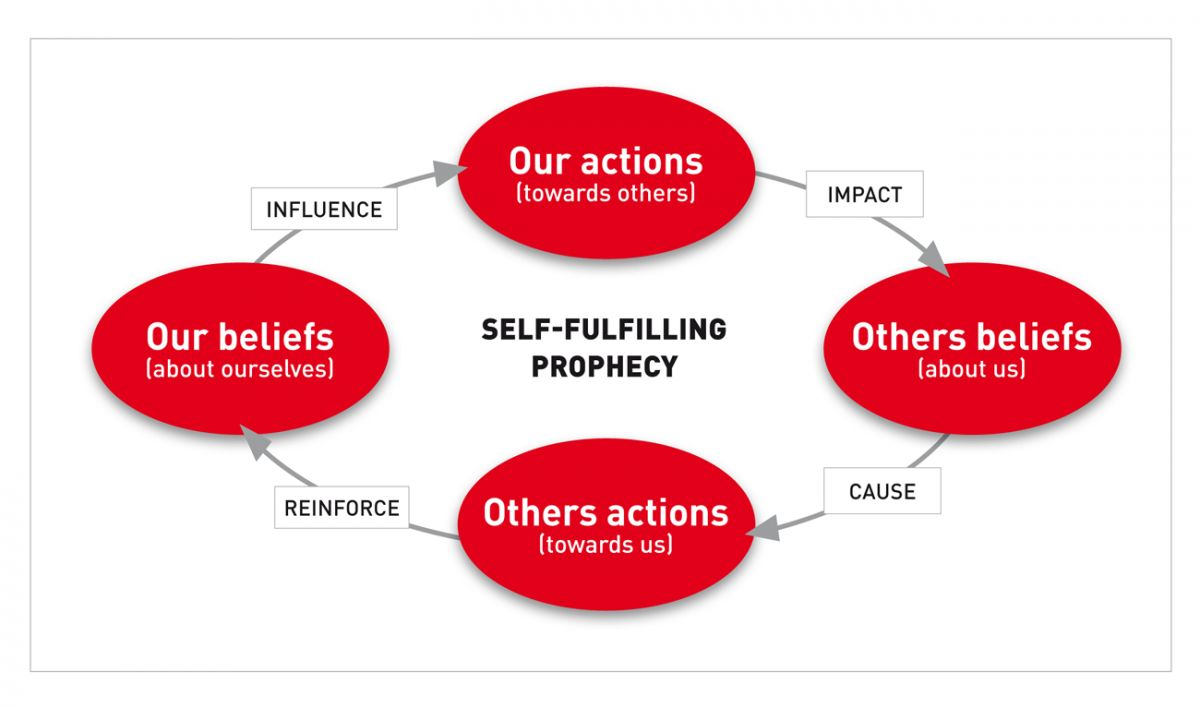Why invest in communication (part 5)
Written by Miguel Ángel Díaz, Iván López Vásquez, Cindy Adams and Antje Blättner
“Know thyself”, Socrates said. In this last section, we look at "triggers" which cause us to behave in certain ways, and how to address them.
Article

Key Points
There are a series of external and internal stimuli that strongly influence how we communicate. The quality of our communication depends on the bridge we create between the stimuli and our response.
Triggers in communication
Introduction
Mrs. Ciervo walked into the clinic and asked: “No one’s here?” Christina, the veterinary nurse who was behind the counter, looked her in the eyes and very seriously asked her: “What, I’m not somebody?!”.
“Girl, I was only asking if any veterinarians were available. What’s gotten into you?” asked Mrs. Ciervo, raising her voice.
“I’m not a girl, I’m a married woman and a mother of two. And good morning, if you hadn’t noticed that you didn’t even say hello when you entered”, Christina said.

From there the conflict gradually escalated until Mrs. Ciervo left feeling angry and Christina was brought to tears of rage and frustration. She knew that she had been wrong to overreact, but she hadn’t been able to control herself (Figure 1).
There are a series of external and internal stimuli that strongly influence how we communicate. The quality of our communication depends on the bridge we create between those stimuli and our response.
What are these stimuli or triggers that we need to pay attention to?
External triggers
Please ask yourself the following questions to assess the situation of your practice [1] [2].
1. Environmental cues
Does the setting help the communication with clients be more fluid so that they can be more informed, learn, and feel comfortable and respected?
Some examples:
- Is the parking lot clean and with available spots?
- Are they always greeted at reception with a smile plus a greeting for the pet?
- Is there educational information in the waiting room about handling and feeding pets?
- Can cats and dogs be separated without bothering each other?
- Are there educational resources like anatomical models and a whiteboard for writing on in the doctor’s office?
- Do I make sure not to examine patients in the reception area or on the go outside of the office?
(See the Veterinary Focus Special Edition “Improving the pet owner experience in your practice”.)

2. Time
Are you in the same mood in the morning as in the afternoon? Do you have more patience at the beginning of your shift? Are you most cheerful and upbeat as the day goes on?
Ask yourself... “When I arrive nice and early to the clinic I seem more relaxed, I greet people, I smile and I listen more. But, when I arrive with little time to spare, I don’t stop to smile and greet people. That is when I convey stress and make communication more difficult.”
3. Certain individuals
Some veterinarians and veterinary staff get very stressed dealing with certain clients, like what happened with Mrs. Ciervo for instance. Others seem extremely empathetic when the client is elderly or very young.
Can you recognize a type of client who helps or hinders you in putting your best self forward when communicating?
Is there some kind of companion that makes things easier for you? A whining complainer saying how unfair life is for him or her? Maybe an employee or boss who is never satisfied and constantly asks for more?
4. The recent past
Are you aware of something that recently happened that could help or hinder your communication? You could still be tense after a difficult surgery and are talking too fast. After talking with an angry client, try taking a break before seeing the next patient. Ask yourself this: Am I ready to be my best self after what just happened?
5. Mood
Our limbic system performs a scan five times each second looking for signals in our environment: am I safe or in danger?
Our verbal and body language send messages that are picked up by our clients to detect the tiniest signal and decide whether or not it is a good idea to remain (Figure 2). So observe your mood and be aware of the signals you are sending your clients!
Examples for sending good signals: Walking with good posture, calmly, smiling, speaking clearly, without stumbling over your words. Maintaining eye contact when you speak. Scientific studies have shown that by changing our posture we can change our mood [4]. See few examples in (Table 1).
| External trigger | Positive | Negative |
|---|---|---|
| Environment cues |
|
|
| Time |
|
|
| Certain individuals |
|
|
| Recent past |
|
|
| Mood |
|
|
Table 1. Examples of positive and negative triggers.
Internal triggers
There are some “internal triggers” that influence our mood that we should consider in order to have more positive interactions (Figure 3).

1. Avoid “labeling” our clients
When we label someone, we train our brain (which is neuroplastic and learns very quickly) that “we see difficult clients all the time”, which predisposes us to confront interactions based on our prejudices and is rarely helpful.
If you mentally label Mrs. Marta, that owner of a 15-year-old cat, as: a complicated client, who never understands, who talks too much, etc., that is what you will unconsciously convey in your non-verbal language when you talk to her. And it is highly likely that she will perceive that you are sending non-verbal messages that are different from your words.
2. More than dealing with difficult clients, we deal with “difficult interactions”
This distinction is fundamental to having a positive predisposition in a conversation, no matter what topic must be discussed. The most frequent causes of difficult interactions are:
- First when the vet practitioner doesn’t listen to the client.
- A lack of flexibility (empathy, compassion or an open mind) on the part of one or both participants.
- Third, the misaligned expectations between what the client wants and what the veterinarian/veterinary assistant thinks or could do.
- Finally, failed outcome, for instance when the owner cannot afford a treatment, or when they can but the pet does not respond as expected.
3. Are difficult interactions more common in our profession, or are they a product of our “attentional focus”?
Think about it a minute... based on everything you’re experienced in your career; do you think that our profession has more good moments or bad moments with clients? If you answered that you’ve had more bad moments than good ones, then ask yourself: are the bad moments really more common? Or do you select, pay attention to and remember the difficult moments you’ve had, making them more intense, so they dominate your thoughts and prevent you from appreciating the many good and beautiful moments of your job?
We must consider the power to focus on the positive as a modeler of how our brain looks at its surroundings (Positive explanatory Style).
4. In our appointments there are at least three participants
The three participants are the owner, the pet and the veterinarian/veterinary assistant. As veterinarians/veterinary assistants we must give our attention, respect and cooperation to pet and pet owner. This is because our clients are also constantly observing and scanning the level of care, compassion and love with which we treat their “child”.
5. Interactions are “flexible”
If one is going badly it could still end well, the invitation is for us to take this as a challenge and use tools to revert it back to an outcome that is favorable for everyone involved.
References
- Bungay Stanier M. The Coaching Habit, 2016 Box of Crayons Press.
- Goldsmith M. “Triggers. Sparking positive change and making it last”, 2015, Profile Books.
- https://www.franklincovey.com/blog/2017/9/29/carry_your_own_weath.html
- Cuddy A. “Presence”, 2016, Orion Publishing Group Ltd.
Miguel Ángel Díaz
DVM
Spain
Miguel received a degree in Veterinary Science in 1990. After working at several clinics he opened his own clinic in 1992 which grew from a two-person office to a 24/7 hospital with 17 employees. After running his hospital for 25 years, he handed it over to his team in 2017 in order to concentrate exclusively on his great passion: coaching.
Miguel is the director of the company New Way Coaching, aimed at helping veterinarians become better leaders. He has been educating and training veterinarians in Europe, Latin America, and Asia since 2009 in leadership, motivational techniques, effective communication, handling objections, conflict resolution, influence and persuasion. He spends his days giving individual coaching sessions, private training for his clients’ teams, and workshops and conferences for major veterinary sector companies.
Miguel is an International Coach Certified by the International Coaching Community and the Center for Executive Coaching (USA). He is a Certified Trainer for Edward de Bono’s Six Thinking Hats.
He has been an international speaker at conferences in over 10 countries on three continents. He is the author of the book “7 Keys to Successfully Running a Veterinary Practice”, which has been translated into English, Polish, Chinese and Italian.
Iván López Vásquez
DVM
Chile
Iván comes from a family of veterinarians; his father and older brother share the same passion. He obtained his degree from the Universidad de Concepción in 1991, worked a few years at a small clinic and then shifted his career towards sales and marketing, holding several positions at multinational companies in the domestic pet market in his native country.
Since 2008 he has been the executive director of Vetcoach, a business and organizational consulting company that specializes in the pet veterinary sector in Latin America, where his vision is to create “a new standard for the veterinary world”.
Iván has studied marketing, innovation, coaching and positive psychology. Today he is a strategic business consultant in organizational development and innovation, an ORA Coach (Organizational Role Analysis), creator of initiatives to improve the well-being (happiness) of veterinary students and qualified veterinarians, as well as high-value training programs for veterinary companies and their teams on subjects such as management, wellbeing, communication skills and positive leadership.
Iván has written several management articles for veterinary journals and is an international conference speaker in Latin America.
Cindy Adams
MSW, PhD
Canada
Cindy Adams is Professor in the Department of Veterinary Clinical and Diagnostic Sciences at the University of Calgary, Veterinary Medicine, where she developed and implemented the Clinical Communication Program in Calgary’s new veterinary school. She honed her professional understanding of human-animal relationships serving from 1980-1992 as a social worker in child welfare, women’s shelters and the justice system. Animals were frequently involved in that work. Combining the very different perspectives gained from her experiences in social work and a doctorate in veterinary epidemiology, she became a faculty member at the Ontario Veterinary College, University of Guelph (1996-2006). There she designed and directed the first veterinary communication curriculum in North America and pioneered a research program regarding communication in veterinary medicine.
She helped initiate the Institute for Healthcare Communication, Bayer veterinary communication project. Her research has focused on communication education, veterinary-client communication in large and small animal contexts, animal welfare, companion animal death and human grief. Founder of the International Conference on Communication in Veterinary Medicine, co-author of Skills for Communicating in Veterinary Medicine she has presented widely and advised veterinarians, veterinary practice teams and veterinary educators throughout North America, Europe, Australia and the Caribbean.
Antje Blättner
DVM
Germany
Dr. Blaettner grew up in South Africa and Germany and graduated in 1988 after studying Veterinary Medicine in Berlin and Munich. She started and ran her own small animal practice before undertaking postgraduate training and coaching course at the University of Linz, Austria and then founded “Vetkom”. The company provides training to veterinarians and veterinary nurses in practice management in subjects such as customer communication, marketing and other management topics. Dr. Blaettner also is editor for two professional journals, “Teamkonkret” (for veterinary nurses) and “Veterinärspiegel” (for veterinarians).
Other articles in this issue
Share on social media